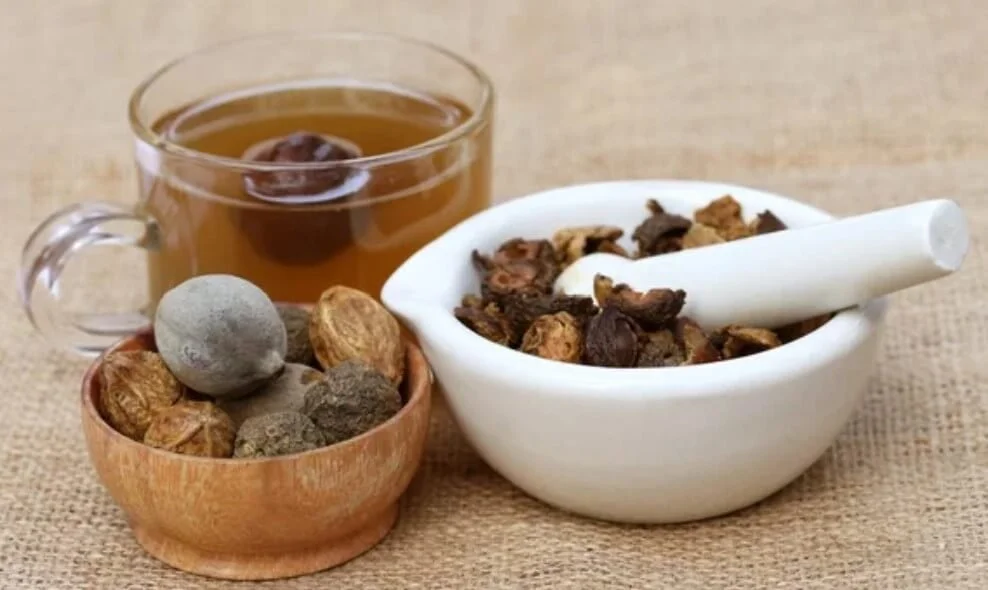Triphala: A Gentle Ayurvedic Approach to Supporting Wellbeing
Did you know that one of Ayurveda’s most prized herbal formulas has been used for thousands of years? In Ayurveda, supporting natural cleansing processes is considered important for maintaining optimal health and wellbeing. There are gentle, natural, and time-tested ways to support these processes and revitalize your health. Triphala, the revered Ayurvedic herb, has been used for centuries to support digestive function and contribute to overall health (Peterson et al., 2017). Discover how this potent yet gentle remedy can help you achieve a healthier, more vibrant you.
As winter ends, this is a good time to focus on supporting your internal systems to prepare for the fresh spring season. Reflecting on the winter months and supporting healthy habits.....
Triphala powder
Let’s prepare our Gut for Spring!
Understanding Triphala: An Ayurvedic Perspective
Triphala is mentioned in the Charaka Samhita and the Sushruta Samhita, foundational texts of Ayurveda in India, as having been used in traditional medicine for over 1,000 years (Peterson et al., 2017).
Triphala, which translates to "three fruits," is a cornerstone of Ayurvedic medicine. It is a potent herbal formulation consisting of three dried fruits (Bairwa, 2025; Pole, 2013):
Amalaki (Emblica officinalis): Also known as Indian Gooseberry, Amalaki is rich in Vitamin C and is traditionally valued for its support of overall wellbeing. It supports healthy sensory processing and promotes healthy bowel movements.
Bibhitaki (Terminalia belerica): Bibhitaki is traditionally associated with maintaining health. It has a drying and strengthening effect on the mucous membranes, particularly the lungs, intestines, and urinary system, which may contribute to digestive and respiratory wellbeing.
Haritaki (Terminalia chebula): Haritaki is traditionally valued in Ayurveda and Tibetan medicine. It is considered a beneficial herb for the digestive system and lungs, supporting their wellbeing.
The combination of these three fruits, also known as “Three-Fruit Harmony" formulation, creates a synergistic effect, making Triphala a valuable tool for supporting overall health. In ancient texts, Triphala is highly regarded (Bairwa, 2025)
Triphala is classified as a tridoshic rasayana, meaning its ability to balance all three doshas (Vata, Pitta, and Kapha), making it a suitable remedy for most individuals. Triphala has five tastes or rasa of the six: sweet, pungent, astringent, sour, and bitter – doesn't contain the salty taste (Peterson et al., 2017).
Potential Health Benefits of Triphala
Source: Bairwa, 2025
Triphala's Benefits: Supporting Overall Wellbeing
While Triphala is traditionally used for supporting natural cleansing processes, it also offers a range of potential benefits for overall wellbeing (Pole, 2013; Ahmed et al., 2021; Jantrapirom et al., 2021; Supriya Sudhakar Bhalerao et al., 2023; Bairwa, 2025). Research has explored its potential role in supporting various aspects of health (Bairwa, 2025).
Digestive Health: Traditionally used for maintaining a healthy digestive tract, supporting regularity, and easing discomfort (Pole, 2013; Ahmed et al., 2021).
Antioxidant Power: Rich in antioxidants, Triphala helps to protect the body against free radical damage and premature aging. Triphala is considered a Rasayana in Ayurveda, meaning it promotes rejuvenation and longevity. Scientific studies have validated Triphala's potential as a source of rejuvenation due to its potent antioxidant properties (Ahmed et al., 2021).
Lung Wellbeing: Triphala is traditionally used to support lung health and may help to ease congestion. Emerging research suggests that Triphala may also be beneficial for managing allergic rhinitis (Jantrapirom et al., 2021). Its anti-inflammatory and antioxidant properties may help to support respiratory comfort
Anti-Inflammatory Effects: Triphala helps to reduce inflammation, and studies have shown its ability to reduce inflammation in arthritis (Bairwa, 2025).
Weight Wellbeing: Triphala may support healthy weight management as part of a balanced lifestyle program, by supporting healthy digestion and metabolism. Studies have explored its potential effects on fat metabolism (Bhalerao et al., 2023).
Skin Health: Triphala may promote clear, healthy skin by supporting healthy bodily functions. It is also traditionally used as a mouthwash to support gum health (Pole, 2013).
Eye Health: Triphala exhibits antioxidant properties that may support ocular health. It is a substantial source of vitamin C as well as flavonoids. Historically, it has been used to support eye health (Bairwa, 2025).
Triphala Tea
Gentle cleanser.
How to Use Triphala Safely and Effectively
Triphala is generally considered safe for most individuals when used appropriately. However, it's important to follow these guidelines:
Start with a Low Dose: Begin with a low dose (e.g., 1/4 to 1/2 teaspoon) and gradually increase as needed.
Take it at Night: Triphala is best taken at night before bed to promote gentle cleansing in the morning.
Drink Plenty of Water: Stay well-hydrated while taking Triphala to support detoxification.
Listen to Your Body: If you experience any discomfort, reduce the dose or discontinue use.
Consult a Practitioner: If you have any underlying health conditions or are taking medications, consult with a qualified Ayurvedic practitioner before using Triphala.
REVIVE Ayurveda's Triphala Recommendations
At REVIVE Ayurveda, we recommend the use of Triphala as part of a comprehensive Ayurvedic cleanse.
We also offer personalized consultations to help you determine the right dosage and form of Triphala for your unique needs.
Explore the Potential of Triphala for Supporting Your Wellbeing
Ready to experience the gentle yet powerful benefits of Triphala? Incorporate this revered Ayurvedic herb into your daily routine and embark on a journey to a healthier, more vibrant you!
Visit https://www.reviveayurveda.com.au/ayurvedic-program or call me at 0449 884 110 to schedule your appointment.
Written by Ann Pallis, Ayurvedic Practitioner in Ashburton, Melbourne.
Disclaimer: This blog post is for Ayurveda informational purposes only and does not constitute medical advice. This information is not intended for use in the diagnosis, treatment, cure or prevention of any disease. Please consult with a qualified healthcare professional before using Triphala or any herbal remedies.
REFERENCES
Bairwa, V. K. (2025). Triphala’s characteristics and potential therapeutic uses in modern health. International Journal of Physiology, Pathophysiology and Pharmacology, 17(2), 19–36. https://doi.org/10.62347/obss5026
Jantrapirom, S., Hirunsatitpron, P., Potikanond, S., Nimlamool, W., & Hanprasertpong, N. (2021). Pharmacological Benefits of Triphala: A Perspective for Allergic Rhinitis. Frontiers in Pharmacology, 12. https://doi.org/10.3389/fphar.2021.628198
Ahmed, S., Ding, X., & Sharma, A. (2021). Exploring Scientific Validation of Triphala Rasayana in Ayurveda as a Source of Rejuvenation for Contemporary Healthcare: An Update. Journal of Ethnopharmacology, 113829. https://doi.org/10.1016/j.jep.2021.113829
Supriya Sudhakar Bhalerao, Joshi, A. A., Suresh Khadke, & Arulmozhi Sathiyanarayan. (2023). Anti-obesity Effects of Triphala at Biochemical and Molecular Level in High-Fat Diet-induced Obese Rats. Pharmacognosy Magazine, 20(1), 30–42. https://doi.org/10.1177/09731296231198316
Peterson, C. T., Denniston, K., & Chopra, D. (2017). Therapeutic Uses of Triphala in Ayurvedic Medicine. The Journal of Alternative and Complementary Medicine, 23(8), 607–614. https://doi.org/10.1089/acm.2017.0083
Pole, S. (2013). Ayurvedic medicine: the principles of traditional practice. Singing Dragon, Cop.



